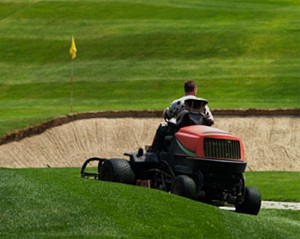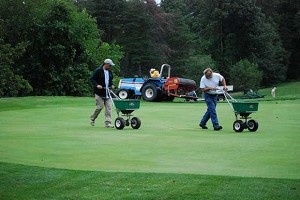Survival Of The Fittest (4 Of 7 In A Series) – More Green…With Less Green. Doing More With Less, Superintendents Becoming Innovative And Creative
By Steve Dowling
The current vogue in the golf industry has been to express phrases such as “affordable golf” yet the golf course industry is struggling for financial survival. There is the reality of club competition with the number of golf courses that have been added in the past decade. In the U.S., we have increased golf course capacity 25% since 1990. While it is true that basic demographics relating to the aging of the “baby boomer” generation has supported some additional golf capacity, it will not absorb all the capacity that has been built or is scheduled to open. This has created a very competitive environment for golf course operators.
The goal at most golf clubs is a presentation, along with bragging rights, of a course that is seen as “lush and beautiful”. Golf courses are in a state of constant change and evolution since they are literally growing! As the trees, grass and other shrubs grow, they interfere with the width of the playing surface of the golf course. In order to reduce the wastage of the surface, these elements forming the major part of the course need to be maintained in a proper and orderly fashion thus increasing the efficiency of the course itself. It is “MAINTENANCE” that drives the image of lush and beautiful and delivers the critical “playability’ that golfers demand in exchange for their business. However, maintenance is expensive, very expensive!
Cost of Maintenance: 60% – 75% of a Golf Club’s Operating Expense
On average, the maintenance budget constitutes 60% to 75% of the overall course’s budget. The course itself and course conditions are the backbone of the golfing experience. Unfortunately, as the economy has soured and golfers revert to shopping for less expensive tee times the cost of maintenance is only increasing. This is as a consequence of rapidly rising costs for course maintenance coupled with at best, static public play and membership levels and hence revenue streams. Unfortunately, it is likely that income will reduce further given the difficult economic times we now face and the effect that this will have on the discretionary spending of consumers. Most courses have capitulated in pricing to a point they can no longer yield to pricing their product at a lower price point and still survive.
Maintenance budgets have necessarily been pulled back in light of declining play, and more than a few courses are quite literally in a “do or die” year. Cutbacks in spending alone will not solve the concern; it will take more play and, with private clubs, a larger membership base.
Where the economic sustainability of golf clubs is under threat, serious attention needs to be turned to expenditures, which may require extremely radical actions. Maintenance costs may need to be reined in further.
A major contributor to this article is Superintendent Scott Thayer of the award winning and nationally rated Legends Club in Prior Lake. The reality at many clubs, both public and private, is that “Superintendents are being asked to do more with less,” said Scott Thayer.
WHAT IS MAINTENANCE? Sample Golf Course Maintenance Mission Statement:
• To prepare, preserve and maintain the golf course in excellent playing condition as the major club asset and to afford the opportunity to provide enjoyment to its golfers and guests.
• To protect, understand and fulfill the golf course architect’s vision and goals for a firm, fast and fair golf challenge for all levels of player abilities.
• To plan and execute programs and procedures that maintains a superior golf experience as well as enhances and protects the environment, property and aesthetics of the club.
Each element of golf course maintenance is assigned extensive “standards” such as frequency (e.g. “cut fairways to .50 inches 5 times per week during prime growing season” etc.). As we think of golf course maintenance we seldom focus on the extensiveness and diversity of the Superintendent’s responsibility. Below is a partial checklist that Superintendents face daily/weekly. Each is normally accompanied by extensive standards not covered in this article:
• GREENS: INCLUDING GREEN COLLARS; GREEN APRONS
• TEES
• FAIRWAYS
• ROUGH: PRIMARY & SECONDARY
• PREPARATION FOR DAILY PLAY / GOLF COURSE SET-UP
• EQUIPMENT TRAINING AND SAFETY
• BUNKERS
• WATER FEATURES
• IRRIGATION SYSTEM AND WATER
• TREES
• WOODLANDS
• SWAMPLAND OR BOG
• CART PATHS AND ROADS
• PRACTICE AREA
• CARTS
• CLUBHOUSE
• CLUBHOUSE GROUNDS
• NURSERIES
MAINTENANCE BUDGET
Primary maintenance expense categories:
1) Labor Costs
2) Consumables (fuel, fertilizer, pesticides etc.)
3) Equipment
LABOR
Labor is the biggest line item in virtually any budget, generally consuming 50% to 70% of a golf course maintenance budget. Golfers expect near-perfect conditions, and it takes labor to meet these expectations. Having fewer employees means that fewer tasks can be completed daily.
CONSUMABLES
Most golf course products (fertilizers, herbicides, insecticides, etc.) are petroleum based, and their cost is increasing. The cost to get these products to the golf course is increasing, too. In fact, fuel costs and fuel surcharges affect delivery costs for virtually everything, including seed, sod, topdressing, etc., not to mention the direct cost of fuel needed for the maintenance operation. Some courses, including Legends Club, are substituting bio-diesel for traditional diesel fuel.
EQUIPMENT
The challenge for clubs when purchasing machinery is to get the balance right, namely: Quality to achieve the standard of playing quality required; Capital cost for machinery; Efficiency of machinery (cost/hour) and Maintenance costs for the machinery. Changing to hand mowing greens could have benefits in terms of reduced costs to buy and maintain the machinery, reduced fuel usage, improved turf quality and health benefits for those doing the mowing. The problem with walk-behind mowing is that it is more time consuming. However, if we slow down the growth of the grass with chemicals, a reduced frequency of mowing will be possible without a reduction in turf quality. Hence the overall amount of man hours required may be no different. Other points to consider are if growth rates of turf are reduced to the suitable minimum, machinery will last longer and hence the ongoing replacement cost will be reduced significantly. For example, if you mow three times a week rather than six or seven times a week, mowers will last twice as long. Let’s look at equipment costs for a minute. A new fairway mower with a 10′ cutting width costs approximately $38,000 today. A mower with the same width cost $22,000 in 1995. This near 75% increase in the cost of ownership is way beyond the increase in the Cost Price Index over that period. Even if you ascribe a 7 Year useful life, this new mower is costing about $20/hr. vs. $12/hr. in 1995. An analysis of walking greens mowers also reveals a similar pattern. A 22″ Mower in 1995 was $2,500 and is over $4,000 today. Clearly, today’s superintendent is not getting much help in lowering expenses from the equipment manufacturers.
Innovation and Creativity
Superintendents have always been able to provide quality golfing conditions while working within a modest budget. It just keeps getting more difficult, year after year, to provide quality conditions as several uncontrollable factors occur. As the golf maintenance budget has remained lean over the last few years, the cost to operate a golf course has drastically increased. Fuel, fertilizer, pesticide, and material prices have skyrocketed. The minimum wage increase affected labor costs. Equipment and parts prices have increased. Every aspect of course maintenance has been affected by price increases, causing maintenance cut backs to be dramatically accentuated. Working with a modest budget has been difficult for golf maintenance departments. It is an enormous challenge to continue providing top quality playing conditions on a reduced budget. But so far most qualified Superintendents have been able to do so. Superintendents have had to redesign their maintenance strategy and come up with some innovative ways to accomplish their goals at a lower cost. A few of the adjustments noted by contributing Superintendents include:
• Reduced the payroll expense through rescheduling work plans, reducing hours worked
• Increased the size of many natural areas on the course, thus reducing mowing labor, fuel costs, fertilization, and weed control
• Use of turf growth slowing chemical (e.g. Primo)
• Skipped fairway mowing 1 day per week
• Replaced one day of green cutting with rolling
Concentrating labor input in the key playing areas – the course may look a little “rough around the edges” but the game can be played and enjoyed as it was intended.
• Reduced bunker raking
• Reduction in fertilization of rough and out-of-play areas
• Skipped a scheduled lime application
• Introduction of additive that holds water longer
• Removed improvement projects from the budget
• Reduced labor and fuel costs during early spring and leaf season
Presentation of the Golf Course with Less Resource Input
A consequence of reducing staffing levels and maintenance inputs is that the presentation of the golf course will probably (inevitably) need to change. Concentrating on the key playing areas by maintenance staff will ensure that the game itself can still be enjoyed as it always was. The aim is to get to minimal inputs while preserving the playability customers are accustomed to with fewer resources – doing more with less!
Players may need to learn to accept a slightly more “unkempt” or natural look that is a consequence of retiring areas from maintenance. Reducing the maintained area and concentrating resources in the key playing areas will reduce costs.
In summary, maintenance staffs continue to strive towards keeping their club as the best golf course in the area. As supply prices continue to increase and the maintenance budget remains status quo, golfers will eventually see a decline in the condition of their course. It is the goal of the maintenance staff to fight the inevitable and not let a decline become apparent. Superintendents have many years of experience maintaining courses through this tough financial period.
Budgets at many private clubs and daily-fee facilities are going down or are at least flat. Raising green fees or attracting new members is proving difficult. Overall, revenue for most facilities is also stagnant. Cost increases are evident throughout golf course maintenance budgets.
The bottom line is that if you spend less, you should expect less. Even if you spend the same amount year after year, your buying power decreases. There are no shortcuts. Superintendents need to be innovative in implementing programs, but there are limits.
If golf clubs are to live within their financial means, they need to focus on what is really important and concentrate resources there. Reducing inputs to slow growth to a suitable minimum will produce multiple benefits. In some situations, radical action may be required, which will result in significant changes to the way golf courses are presented. However, provided there is a genuine passion for the game, the enjoyment of it will not be diminished.


